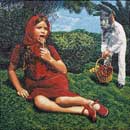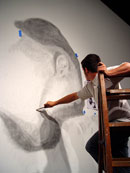|

Prior
 Mondongo Mondongo

Tessi

Grinblatt

Iuso
|
From B.A. to L.A.: Mondongo, Tessi, Iuso, Prior,
and Grinblatt
Exhibition Catalogue Available
January 8 to February 12, 2005
Track 16 Gallery presents "From B.A. to
L.A", an exhibition of contemporary Argentinean art featuring
Julio Grinblatt, Guillermo Iuso, Alfredo Prior, Juan Tessi, and
the collective Mondongo. The exhibition, curated by Kevin Power,
brings together five distinct voices working with poetics of the
everyday. The works “marked by irony, a lightness of touch,
intense perception, critical spirit, ambiguity, laughter, and
stories that never reach a final reading” reveal moving,
telling, and often vulnerable images of the self. The exhibition
runs from January 8 to February 12, 2005, with an opening reception
on January 8, from 6 to 8 P.M. Regular gallery hours are Tuesday
through Saturday from 11 to 6 P.M.
During the mid 1990s Argentina was lauded as
an economic miracle after its leaders decision to peg the Argentine
peso to the U.S. dollar in order to gain foreign investor confidence.
This endeavor failed, however, causing an economic disaster which
left half the population at poverty level. Paradoxically, this
spawned a major creative boom in the Argentine art world, in literature,
cinema, and the visual arts. New and alternative art spaces emerged,
igniting the art scene; some of the artists in this exhibition
have shown their work in these venues as well as in more well
known galleries.
In his series entitled Pasillos (Corridors),
photographer Julio Grinblatt creates a stark narrative using spaces
both alluring and familiar: corridors and stairwells. These spaces
are empty while at the same time seemingly infused with voices
and absence, thus creating the human predicament of waiting for
the imminent, whatever it may be.
Guillermo Iuso’s work consists primarily
of autobiographical installations that make sense of unbridled
emotions. These emotions are then harnessed into fragments and
lists: he maps his own life with long dissertations of statistics
and personal obsessions, from the ordinary and banal to the most
intricate of personal experiences, to produce an intimate diary
that registers the movements of his life.
One of the most well-known Argentinean painters
of the 1980s, Alfredo Prior, exhibits a series of paintings of
freak postmodern characters on vinyl records, perversely bringing
together the world of art, religion, and childhood nostalgia.
In his piece Silly Symphony, the subjects “little
bears” are painted on twenty seven discs set out like a
chessboard in an attempt to intensify the patheticism of representational
conventions.
The prefabricated clichés of homoeroticism
which flood the Internet as well as an obsession with the canon
of perfection of the male physique, are apparent in the elegant
fluid line drawings of Juan Tessi. Tessi's large-scale, realistic
renderings reveal almost photographic detail, yet they take
on different connotations from their source Internet images. Occupying
Track 16 Gallery for two weeks prior to the exhibitions opening,
Tessi will create a series of drawings reminiscent of black-and-white
films; the immense delicacy and intimacy of his work relates both
to the source of the image as well as its new context
Mondongo, a collective
formed in 1999, includes artists Agustina Picasso, Manuel Mendanha,
and Juliana Laffitte. Mondongo constructs a portrait gallery
in which each work exhibits a play between material and personality: Britney
Spears with supermarket price tags, a mass consumption pop icon;
David Bowie in glitter as a glam rock idol of the seventies;
the Pope made out of communion wafers; the Spanish Royal Family
composed of small mirror fragments. By using food, Mondongo
comments on the bloated excesses of contemporary living; their
Pornography series is created with cheap-brand biscuits that
now litter the world like the images they represent. In La Caperucita
Roja (Red Riding Hood), the medium is plasticine, evoking memories
of childhood toys as well as a parallel to the slow process
of oil paint. Mondongo seeks to undermine a variety of systems,
whether it be the myth of the individual artist, the idea of
institutional power, or the art system itself, and they do so
by rooting themselves in the popular. It is in the popular that
they find their material, the "ground zero" of consumer
society: trinkets, cookies, sausages, jellybeans, and other
ubiquitous items.
|